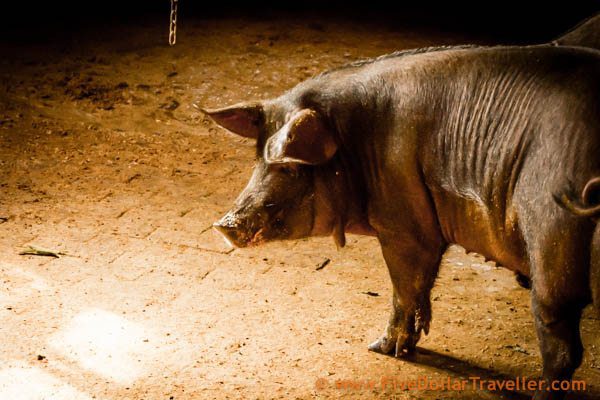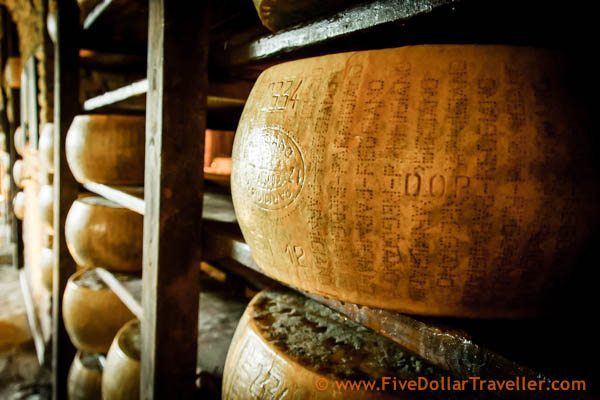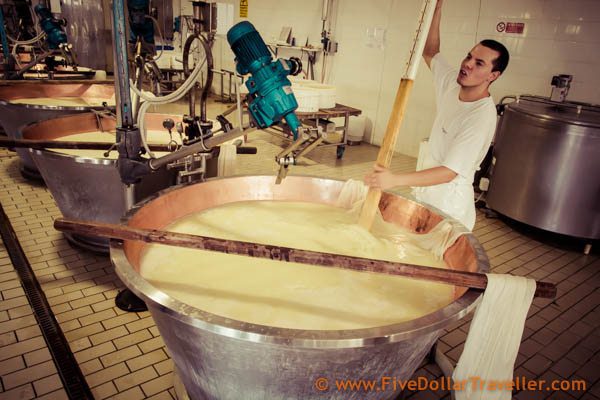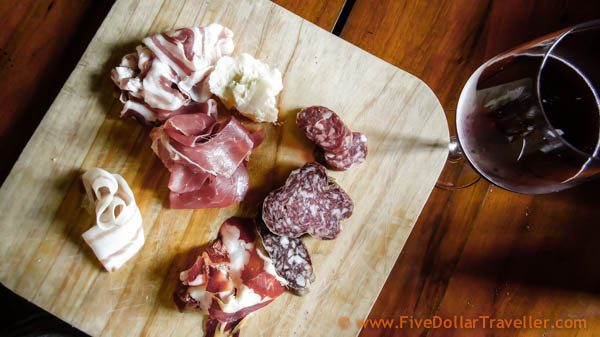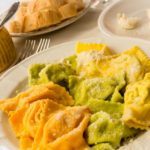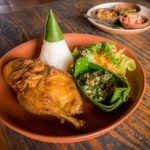The Italians have been holding out on us!
While they have been happily exporting Parma ham to the world, they have been keeping a secret. A secret that all you meat eaters, and ham lovers of the world will want to know about…
There’s another ham!
Yes, I can hear your gasps of shock and see your instantaneous puddles of drool, at the idea. So, let me explain more.
Cured ham is an Italian legacy. And none are as famous as the hams you find in the region of Parma, Emilia-Romagna – proclaimed by many as the gastronomical epicenter of Italy.
This extraordinary area has been dry curing hams since the days of the Romans. In fact, it’s documented that they would often go on long conquests with a couple of cured hams slung over their trusty steeds. Astoundingly, it’s been made to the same exact recipe to this very day…
Parma ham (in Italian, Proscuitto di Parma), you will instantly know for its thin slices, pinky/ red colouring, and salty, divine flavour.
But, it’s exclusive and delicious little brother you likely won’t have tried…
Its name is Culatello, and comes from the same region as Parma ham – however, this is made a little differently. In fact, it is only so amazing because of mold. That’s right mold. The mold is formed due to the unique mists and humidity of the area.
Tasty and Interesting Facts about Culatello:
- There are only 50,000 Culatello hams produced per year (Compared to Parma ham – 9 million hams per year)
- The word Culatello means “little backside”
- The pigs are usually black pigs which are generally fed locally produced, organic feed.
- The only ingredients allowed to be used on the ham are salt, pepper, garlic, and wine.
- Unlike Parma ham, it is a boneless piece of meat – the rear part of the pig’s leg
- The ham once shaped, is wrapped in pigs bladder and left to cure for 8-12 months, before it’s moved to the cellar. It then can be left for another 1 and a half to 3 years.
- Mist from the Po river and the humidity of the area work together to create a unique mold on the ham which develops the flavour.
- There are only 22 producers in 8 villages in the whole world (ham not made in this area is not considered ‘Culatello’. Just like Champagne can only come from one area of France)
If you do wish to experience this ham for yourself it’s available in local delicatessens, but we decided to go straight for the source. Just 45 minutes drive outside of Parma, you can visit the small town of Polesine Parmense. It’s here where we found ourselves standing in a 14th-century castle known as Antica Corte Pallavicina.
If you are Australian, and an avid Master Chef fan, you might recognize this place from the 2012 series where finalist was sent to Italy. Here they met the Michelin star winning, head chef of the Antica Corte Pallavicina restaurant – Massimo Spigaroli. We actually met an Aussie couple that was staying there for that very reason.
This extraordinary medieval building is nestled against the Po River. A river that is famous for its salt, and a major factor to why the cured ham of the Parma region is so unique and delicious. It was here that we met Giovanni our guide for the 1/2 day tour with Food Valley Travel.
As this is a brand new tour we were the only ones booked. Which turned out really lovely, as instead of driving around in our hire car we jumped on a few available bikes and rode around the tiny village of Polesine Parmense.
You can’t have ham without cheese…
It turns out, Polesine Pamense is not just hiding one of the most exclusive, delectable hams in the world, they also make Parmigiano Reggiano, that’s Parmesan Cheese to you and me. Not the pre-grated rubbish you buy in your local 7-eleven. This is top of the line cheesy awesomeness and we were off to the factory to see exactly how it’s made.
Tasty and Interesting Facts about Parmesan Cheese – mmm cheese
- It takes a total of 25 days to create a 40kg wheel of parmesan cheese
- 500 liters of milk is used to make each wheel
- The milk is warmed to 60 degrees Celsius, which turns it into an almost ricotta looking substance (which tastes like eating the eraser of a pencil – trust us)
- The cheese is placed in the round molds and then left in salted pools for 22 days (part of the 25-day process)
- Each wheel of cheese is aged for 1 year and then sold for 500 euros per wheel.
- This factory makes 54 wheels per day – that’s 27,000 euros worth of cheese every single day!
After the tour, we left the delicious cheese behind and jumped back on our bikes to head to the piggery. Along the way, we passed vast fields full of crops.
These pigs are very, very important to the locals. So much that many of the crops are to feed them. These piggies aren’t living off slop and gruel. It’s organic corn, barley, acorns, tomatoes and leftover whey from the parmesan cheese factory. Did we mention that the local tomatoes are famous as well? They are used in many traditional sauces.

The first stage of aging is in a well-ventilated barn
The piggery is to be as expected – stinky. But the main show was the shed which contained the already prepared Culatello – cut, salted, seasoned, wrapped in its bladder encasing, and hung to dry. We sadly didn’t get to see the ham being prepared, as that is done between October and February to follow the traditional seasonal production schedule.
Unlike mass produced Parma ham, which is stored in huge refrigerated factories, the Culatello is still made the same way it has been for 2 thousand years. This means they have to wait for winter to start preparing the hams.
The leftover parts of the pig are used to make a variety of other meats – as little as possible is wasted. If you’ve tried the local salami or Spalla (shoulder) or Coppa (neck) these are some of the tasty creations made from the leftovers.
After a quick visit to see the mummy pigs and their babies, it’s on the bikes and back to the castle to check out the final stage of making Culatello ham – The castle’s medieval cellar.
It is here that for centuries local producers have hung their hams and allowed the mist from the river and humidity of the region to do its work and create mold. The hams generally remain cellared for 12 months before being ready to serve.
The Tasting
One could not go on such a tour without experiencing first hand, what makes this ham so special. Culatello can be sold for over 80 euros a kg – it’s pretty special.
We had no idea what a treat we were in for.
Our plates were brought out to us covered by a cloche, or in normal people terms, a large, fancy, silver lid. (I seriously just had to google that – now both you and I have learned something new today).
anyways……
Once what lay underneath was revealed we were pleasantly surprised at the variety of meat available to try. All of the sections of meat that had been discussed throughout the tour were available for tasting, with a basket of warm freshly made bread. There was even some of the local parmesan cheese on there.
The flavours ranged from delicately salted to creamy – it’s almost too difficult to explain. All is washed down with the specialty sparkling red wine of the region, Lambrusco – this one also being produced by the team at the castle.
This was certainly a meal that fit its elegant 14th-century surroundings.
Have this experience for yourself
This tour is brand new. You get to experience the process and the end products first hand, something that before would have only been available to guests at the castle. This means you can quite literally get a taste of the high life at a fraction of the price.
The visit to Antica Corte Pallavicina was a highlight of our trip to Italy. And we would love to visit again. One of the best things about this tour was how genuine and casual it was. You really feel part of the heartland of Italian cuisine, not like you are on a tour at all.
Our guide Giovanni let us know that in 2015 they will be offering a brand new experience – The School of Cured Meat. A one week course that takes you through the process of curing meat from beginning to end. Sounds like our sort of school.
As for the regular half day tour, you can learn more and book up your tour at Food Valley Travel
Tel: +39 0521 798515 Fax: +39 0521 786631 Mob: +39 335 5685947
————–
If you were stuck on a desert island, what’s the one Parma specialty you’d choose to have with you: A Cured Ham or a wheel of Parmesan Cheese?
You Must Choose ;-)
Leave us a comment below
————-
Disclaimer: We received our Culatello experience complimentary. As with all sponsored content on our site, our reviews are our own opinions. This article contains affiliate links. Thanks for supporting our blog by using these links

